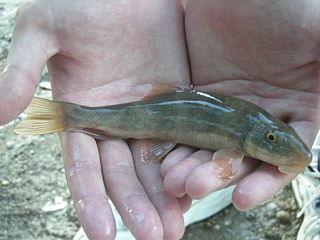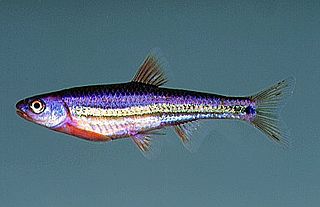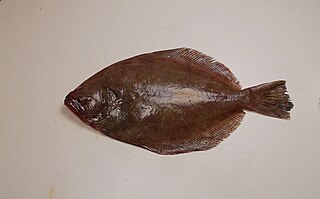
Flounders are a group of flatfish species. They are demersal fish, found at the bottom of oceans around the world; some species will also enter estuaries.

Rhinichthys, known as the riffle daces, is a genus of freshwater fish in the carp family (Cyprinidae) of the order Cypriniformes. The type species is Rhinichthys atratulus, the blacknose dace. Rhinichthys species range throughout North America.

Citharichthys is a genus of flatfish in the large-tooth flounder family, Paralichthyidae. They have both eyes on the left sides of their heads. They are native to the oceans around the Americas, with a single species, C. stampflii off the West African coast. Most are found in relatively shallow depths, but the genus also includes species found in deep water and species that enter fresh water.

Catostomus is a genus of fish belonging to the family Catostomidae, commonly known as suckers. Most members of the genus are native to North America, but C. catostomus is also found in Russia. Fish from different species of the genus are known to readily hybridize with each other.

Paralichthys adspersus, the fine flounder, is a species of large-tooth flounder native to the eastern Pacific Ocean, along the continental shelf from the coast of Ecuador in the north to the coast of Peru in the south.

Astroblepus is a genus of fish in the family Astroblepidae found in South America and Panama. This genus is the only member of its family. These catfishes are primarily found in torrential streams in the Andean area. Astroblepus pholeter and A. riberae are troglobites adapted to living in subterranean water systems. These species are typically small, less than 10 cm (4 in). The largest species reaches 30 cm (1 ft). These fish have suckermouths like those of loricariids. They have two pairs of barbels, maxillary and nasal. The dorsal fin spine lacks a locking mechanism. These fish also have odontodes, tiny teeth on their skin. All species exhibit a conical, pointy type on their fin rays like that found in other loricarioids; other species also exhibit a blunt type that is only found on their skin.

Notropis is a genus of freshwater fish in the family Cyprinidae. They are known commonly as eastern shiners. They are native to North America, and are the continent's second largest genus.

The olive flounder, bastard halibut or Japanese halibut is a temperate marine species of large-tooth flounder native to the North-western Pacific Ocean.

Farlowella is a genus of fish in the family Loricariidae native to South America. This genus is broadly distributed in Amazon, Orinoco, Paraná and coastal rivers of the Guyana Shield. It is absent from the Pacific slope of the Andes and from the coastal rivers of the Brazilian Shield. Many of these species are kept in aquarium. This genus has a unique body shape that resembles of a thin stick of wood. The body is slender and elongate, often with a pronounced rostrum and a brownish color with two lateral dark stripes beginning at the tip of the rostrum, passing over the eyes and ending at the tail, which are periodically interrupted on the caudal peduncle.

The summer flounder is a marine flatfish that is found in the Atlantic Ocean off the East Coast of the United States and Canada. It is especially abundant in waters from North Carolina to Massachusetts.

Paralichthys lethostigma, the southern flounder, is a species of large-tooth flounders native to the eastern and gulf coasts of the United States. It is a popular sports fish and is the largest and most commercially valuable flounder in the western North Atlantic Ocean and Gulf of Mexico. It is a "left-eyed flounder", meaning the left side is pigmented and is the "up side".

Hippoglossina oblonga, is a flatfish and member of the large-tooth flounder family Paralichthyidae. This species has been placed in the genus Paralichthys by some authorities.
P. californicus may refer to:

Cyphocharax is a genus of fish in the family Curimatidae native to South America.

The Gulf flounder is a species of saltwater flounder.
Stenobrachius is a genus of lanternfishes.

Ancylopsetta is a genus of large-tooth flounders mostly found along the Atlantic coast of the Americas with one species found along the Pacific coast.

Paralichthys is a genus of large-tooth flounders. Most species are native to the coastal waters of the Americas, but P. olivaceus is from northeast Asia. The largest species reaches about 1.5 m (5 ft) in length.
Fourspot flounder or four-spotted flounder is a common name for several fishes and may refer to:
Isthomosacanthidae is a family of parasitic spiny-headed worms.















